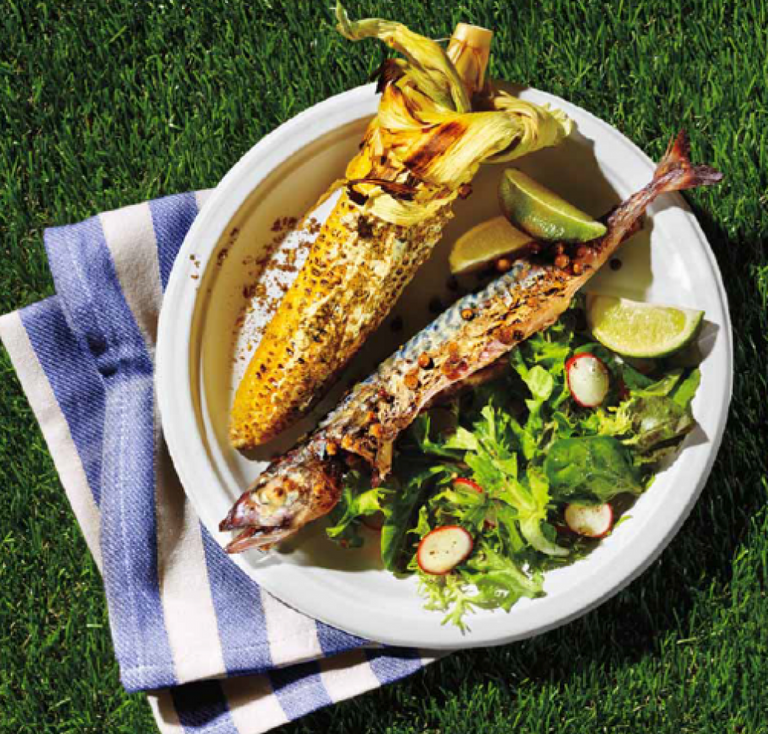
Receta para personas n. 4 / Recipe for people no. 4
Nota: 695 calorías por porción / Note: 695 calories per serving

- 2 dl de vinagre de vino blanco
- un kg de manzanas verdes (Granny Smith)
- 100 gramos de harina,
- un limón sin tratar
- mucho aceite para freír
- sal
- pimienta

- 2 dl of white wine vinegar
- one kg of green apples (Granny Smith)
- 100 grams of flour,
- one untreated lemon
- a lot of oil for frying
- salt
- pepper

25' + 25' de cocción / 25' + 25' cooking time
- Descorazona las manzanas y córtalas en rodajas finas.
- Las rebozamos en harina y las sofreímos en una sartén con abundante aceite caliente.
- Colócalas sobre papel de cocina absorbente para que pierda el exceso de grasa.
- Limpiar las caballas, destriparlas y lavarlas con vinagre diluido en medio litro de agua.
- Cocínalos en la parrilla caliente durante unos 5 minutos por lado.
- Acomoda el pescado sobre una cama de manzanas fritas, espolvorea por encima la ralladura y el jugo de un limón.
- Agrega sal, sazona con pimienta recién molida y sirve.
Para preparar este plato se eligieron manzanas Ganny Smith por su consistencia y sabor ligeramente ácido.
A falta de ellas, puede servir cualquier manzana que tenga las mismas características.
Entre las últimas creaciones, Pink Lady es la que mejor se corresponde con este identikit.

- Core the apples and cut them into thin slices.
- We coat them in flour and fry them in a pan with plenty of hot oil.
- Place them on absorbent kitchen paper so that they lose excess fat.
- Clean the mackerel, gut them and wash them with vinegar diluted in half a liter of water.
- Cook them on the hot grill for about 5 minutes per side.
- Arrange the fish on a bed of fried apples, sprinkle the zest and juice of a lemon on top.
- Add salt, season with freshly ground pepper and serve.
To prepare this dish, Ganny Smith apples were chosen for their consistency and slightly acidic flavor.
In the absence of them, any apple that has the same characteristics can serve.
Among the latest creations, Pink Lady is the one that best corresponds to this identikit.
¿Qué le da nombre a esta deliciosa y ácida manzana verde? Se dice que su descubrimiento fue realizado accidentalmente por Maria Smith, una inglesa, a mediados del siglo XIX en Australia. La señora Smith, mientras ordenaba el huerto familiar, arrancó algunas malas hierbas, según ella, de las raíces de algunos manzanos del jardín y las arrojó a un rincón. Sólo después de un tiempo se dio cuenta de que esas ramitas viejas y secas estaban brotando... y produciendo pequeñas manzanas de color verde brillante. Inmediatamente comenzó a "cuidar" las nuevas plantas y pronto tuvo una serie de pequeños manzanos con frutos ácidos pero jugosos; también descubrió que la nueva variedad toleraba bien los viajes largos y el almacenamiento.
La historia, quizás un poco elaborada por sus compatriotas, es cierta y la biografía oficial de María se conserva en la ciudad de Ryde, Nueva Gales del Sur: nacida en Sussex en 1799, Maria Ann emigró con su marido Thomas Smith a Australia en 1838, para seguir las nuevas plantaciones de las colonias inglesas. Sólo más adelante en su vida, "Granny Smith" descubrió accidentalmente la manzana que llevaría su nombre y la haría famosa. Las malas hierbas que María erradicó con tanto cuidado de su huerto no eran más que lo que quedaba de viejos manzanos franceses, trasplantados años antes en Tasmania.
Lamentablemente, no sobrevivió a su éxito: dos años después de que comenzara la comercialización de Granny Smith, María murió sin saber que la manzana a la que ella había dado su nombre ganó el primer premio en una feria nacional en 1891 y que después de sólo cinco años exportarse a todo el mundo. Los Granny Smith llegaron a Inglaterra en 1935 y a los Estados Unidos en 1972, mientras que hoy en día todavía se pueden encontrar árboles silvestres de Granny Smith en casi toda Australia.
Se la conoce como “manzana verde” o “manzana para diabéticos” ya que es baja en azúcar y muy ácida; se cultiva casi exclusivamente en el fondo del valle, esto se debe a que en los cerros adquiere un color rosado.

What gives its name to this delicious and tart green apple? It is said that its discovery was made accidentally by Maria Smith, an Englishwoman, in the mid-19th century in Australia. Mrs. Smith, while tidying up her family garden, pulled some weeds, she said, from the roots of some apple trees in the garden and threw them into a corner. Only after a while did she notice that those old, dry twigs were sprouting...and producing little bright green apples. She immediately began to "take care" of the new plants and soon had a series of small apple trees with sour but juicy fruits; She also found that the new variety tolerated long trips and storage well.
The story, perhaps a little elaborated by her countrymen, is true and Mary's official biography is preserved in the town of Ryde, New South Wales: Born in Sussex in 1799, Maria Ann emigrated with her husband Thomas Smith to Australia in 1838 , to follow the new plantations of the English colonies. Only later in her life did "Granny Smith" accidentally discover the apple that would bear her name and make her famous. The weeds that Maria so carefully eradicated from her orchard were nothing more than what was left of old French apple trees, transplanted years earlier in Tasmania.
Unfortunately, she did not survive her success: two years after Granny Smith's marketing began, Maria died without knowing that the apple to which she had given her name won first prize at a national fair in 1891 and that after only five years exported to the whole world. Granny Smiths arrived in England in 1935 and the United States in 1972, while today wild Granny Smith trees can still be found almost all over Australia.
It is known as “green apple” or “diabetic apple” since it is low in sugar and very acidic; It is grown almost exclusively at the bottom of the valley, this is because in the hills it acquires a pink color.
Estas recetas y tantas otras publicadas en #BLURT las pueden encontrar en mis blogs en italiano, inglés y español. Más de 5.000 recetas para darle fantasía y color a tu mesa y hacer una figura digna de un/a chefs con tus invitados.
These recipes and many others published in # BLURT can be found on my blogs in Italian, English and Spanish. More than 5,000 recipes to give fantasy and color to your table and make a figure worthy of a chef with your guests.
Fuentes de la/s imàgen/es / Sources image/s:
Y como siempre me despido de todos con un:
And as always I bid you all farewell with a:

Upvoted. Thank You for sending some of your rewards to @null. Read my last posts to make sure that BLURT burning is profitable for you. Before using this bot please make sure your account has at least 100 BP. Get more BLURT:
@ mariuszkarowski/how-to-get-automatic-upvote-from-my-accounts@ blurtbooster/blurt-booster-introduction-rules-and-guidelines-1699999662965@ nalexadre/blurt-nexus-creating-an-affiliate-account-1700008765859@ kryptodenno - win BLURT POWER delegation@ ctime/burn-bot-liquid-blurtThanks you @ctime!